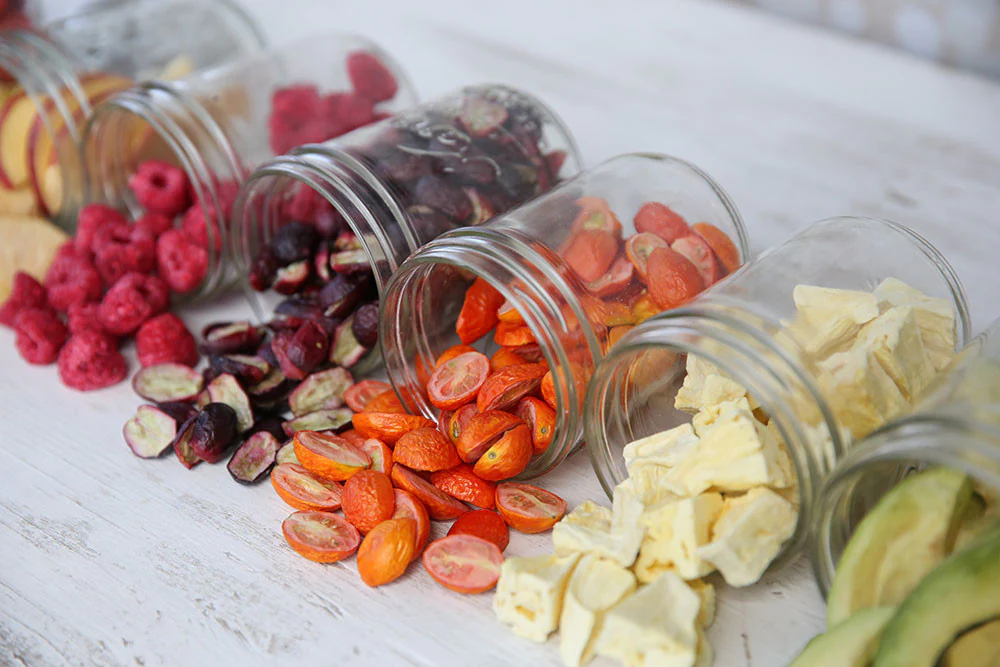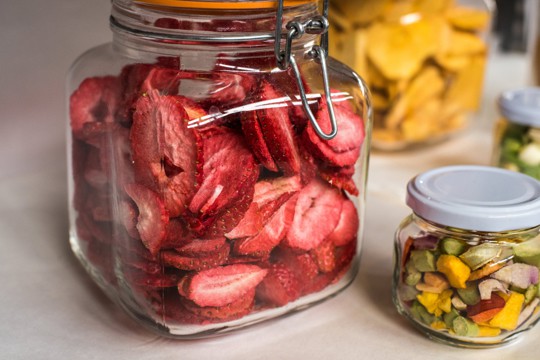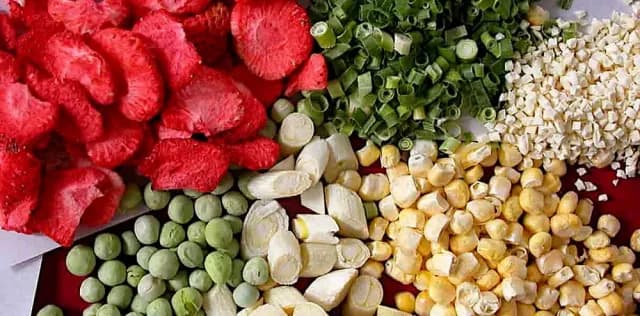Freeze-dried food is an emergency food that is preserved by removing moisture from its contents.
It is usually packaged in a lightweight vacuum-sealed bag with an oxygen absorber and heated to remove all moisture.
This drying process ensures that food will not spoil for 25 years or more.
In this blog post, we’ll discuss the shelf life of freeze-dried foods, how to store them properly, and how to make sure you use freeze-dried foods correctly.
Table of Contents
What is Freeze-Dried Food?
When food is freeze-dried, it is snap-frozen and then placed in a vacuum chamber to remove the ice crystals.

When moisture is removed from this environment, the moisture can be reabsorbed by the air around our dry foods, and they are resurrected in their original form as if they had never been frozen.
Freeze drying essentially locks in all the fresh flavors for many years to come.
The freeze-drying process removes moisture from food.
The process is such that heat, vacuum, and pressure are used to extract moisture from food that does not need to be cooked or prepared before consumption.
Another benefit of this process is that it slows down any spoilage caused by bacteria in these products, even after opening.
All kinds of nasty things happen when food sits on the shelf for too long: Molding, bacterial growth, and other natural processes can cause your fruit snacks to spoil quickly.
Freeze drying prevents all of these problems by preserving our favorite flavors through a simple dehydration technique.
It’s not just fruits and vegetables that can be freeze-dried; we’ve created a range of protein powders, cheese snacks, ready meals, and even desserts.
Related Reading: What is Freeze-dried Food?
How Long Does Freeze-Dried Food Last?
Freeze-dried food is suitable for use anywhere refrigeration is not possible or as an emergency food source.
They can be saved without requiring any saving.
While freeze-dried foods don’t have an as good shelf life as canned foods (about 12-18 months), freeze-dried foods will last a long time if not refrigerated.
Generally speaking, freeze-dried foods have a shelf life of 25 to 30 years, while dehydrated foods have a shelf life of 15 to 20 years.
Once you’ve opened the freeze-dried food and exposed it to oxygen, use it within a month.
Treat any opened freeze-dried food like canned food and store it in a cool, dark place.
If you have an unopened package of freeze-dried foods, be sure to protect the contents from moisture and oxygen with an airtight or storage bag before storing them for extended periods of time.
How to Tell if Freeze-Dried Food is Bad?
Freeze-dried foods are the perfect way to get fresh fruits and vegetables without the weight or hassle of carrying them.
This process can preserve these items for up to 25 years, but how do you know if they’ve gone bad?
Freeze-dried foods should be stored in airtight containers at room temperature (about 20 degrees Celsius).
If the package is not sealed, or the contents feel wet to the touch, the package has deteriorated and should be discarded.
If the contents are dry to the touch, it may still be edible if you can’t find any other signs of spoilage.
If there are visible black spots or mold on the food, throw it away immediately, as this is a sign of bacterial growth and damage to the product.
If freeze-dried fruit is cross-contaminated with raw vegetables in storage, this indicates that the airtight packaging has failed and should be thrown away
How to Store Freeze-Dried Food?

- 1. Make sure the food is completely dry.
A common mistake is to store freeze-dried foods before they are completely dry. Any residual moisture can cause food to spoil. The name of the game is to remove all moisture from food to prolong life.
To make sure the food is completely dry, cut a large piece of food in half and check for water or ice particles. You’ll also want to check to see if it’s still cold inside. If the food has any ice particles inside or feels cold to the touch (don’t be afraid to use your tongue), but the food back in the freeze dryer for one more cycle.
Don’t have your own freeze dryer at home? Don’t worry, you are not alone. If you want to preserve store-bought freeze-dried food, feel free to keep it, just make sure it is minimal or no moisture.
- 2. Select the proper storage.
You have several options for storing freeze-dried food.
Each option offers a higher level of protection. It will depend on how long you want to store the food. Your best bet is vacuum-sealed packaging in a Mylar bag.
Plastic Bag
A simple plastic bag provides minimal protection during long-term storage and can only be used for shorter periods of time. When trying to store freeze-dried foods for extended periods of time, even freezer bags are not acceptable.
Store-bought plastic bags are thin, transparent, impermeable, and break easily. They don’t create significant barriers to air, light, and extreme temperatures, all of which can further spoil freeze-dried food.
Plastic bags are better than nothing, but the other options on this list are far stronger and worth recommending.
Closeable Glass Container
Simple, airtight containers, such as mason jars, are good for foods that need a shorter shelf life and will be eaten more often. This includes foods such as fruits, vegetables, and yogurt. These foods can easily be stored in the pantry for months without additional protection.
Mason jars do a good job of protecting food for short periods of time, but because it’s impossible to remove all oxygen, they won’t keep it indefinitely.
After opening the container, don’t forget to seal the jar tightly.
Vacuum Storage Bags
The next step in storage strength is a vacuum storage bag with a packaging machine (like a food preserver or pulse sealer) that removes all air. Vacuum storage bags are thicker, more durable, and last longer than standard plastic bags.
However, they’re sharp and well-lit, which is a downside. If you plan to store freeze-dried food for an intermediate period of time (1-10 years), then vacuum storage bags should work well. Just make sure to seal.
Some people have complained about the sealing strength and ability of some vacuum seals to keep out air, so this is something to monitor.
Mylar Bags
Mylar bags are the best solution when freeze-dried food needs to be stored for long periods of time. Mylar is a transparent polyester resin attached to aluminum foil. It can be easily purchased online.
Think of it as a bouncy can. Mylar comes in a variety of sizes and thicknesses. Depending on your food sealant, you can remove all oxygen and seal the Mylar bag for maximum protection.
Mylar is the best choice because it is thin, light, and flexible. The packaging does not add any unnecessary weight and folds easily for easy storage and transportation. Mylar is also strong and durable. It is hard to tear or break.
That’s why many of the big names in food storage and food preservation—such as Valley Food Storage, Mountain House, Ogason Farms, and Wise Foods—use Mylar for their packaging.
If you accidentally puncture the bag, you can seal the hole with tape.
- 3. Remove All Air and Moisture
When it comes to freeze-drying preservation, air and moisture are the enemies of proper storage and longevity. During the sealing process, you need to remove as much oxygen as possible.
Oxygen aspirators are an excellent tool for removing residual oxygen from the bag – they remove the last little oxygen. Different sizes of products can be purchased in bulk depending on your application.
Once the package is properly sealed and all moisture and air are removed, the package is ready for storage.
For best results, store freeze-dried foods in a dark place with limited light. The best locations are in the pantry, kitchen cupboard, or emergency food storage box.
Storage temperature is important. Extreme or overheating should be avoided. Storing food at room temperature is ideal.
Conclusion
Freeze-dried food is a dehydrated food that removes moisture from frozen food under vacuum conditions.
Considering how long freeze-dried foods will keep before they go bad, we recommend storing them at room temperature (65°F to 75°F) and in an environment with consistent humidity so they don’t dry out too quickly.
The length of time depends on what kind of food it is, but it can usually last up to 25 years if stored properly.

